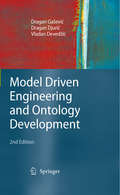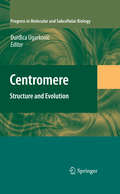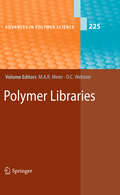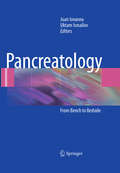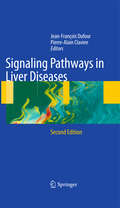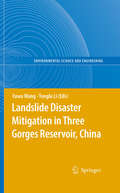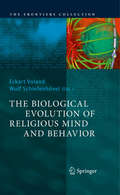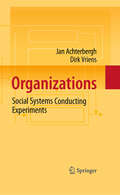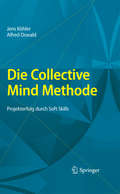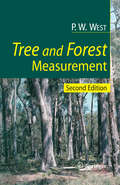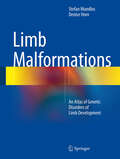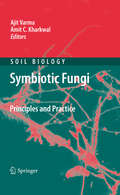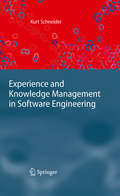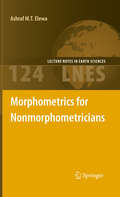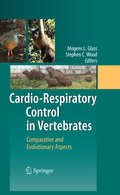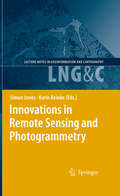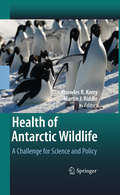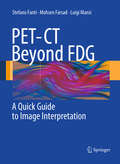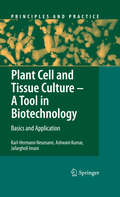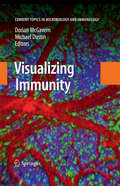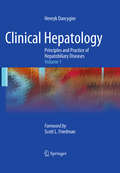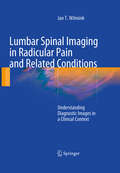- Table View
- List View
Model Driven Engineering and Ontology Development
by Dragan Gaševic Vladan Devedžic Dragan Djuric Jean Bézivin Bran V. SelicDefining a formal domain ontology is considered a useful, not to say necessary step in almost every software project. This is because software deals with ideas rather than with self-evident physical artefacts. However, this development step is hardly ever done, as ontologies rely on well-defined and semantically powerful AI concepts such as description logics or rule-based systems, and most software engineers are unfamiliar with these. This book fills this gap by covering the subject of MDA application for ontology development on the Semantic Web. The writing is technical yet clear, and is illustrated with examples. The book is supported by a website.
Centromere: Structure and Evolution (Progress in Molecular and Subcellular Biology #48)
by Durdica UgarkovicThe centromere is a chromosomal locus that regulates the proper pairing and segregation of the chromosomes during cell division. Despite their conserved, essential function, centromeres are characterized by the rapid evolution of both centromeric DNA and proteins. This book presents current views on centromere structure and identity. It deals with the epigenetic concept of centromere establishment and maintenance as well as with the role of DNA and centromeric transcripts in centromere formation and function. Special emphasis is placed on centromere evolution: different evolutionary models are discussed in detail and the latest research on the evolution of new centromeres and neocentromeres is presented.
Polymer Libraries
by Dean C. Webster Michael A. MeierMeier/Webster: General Aspects of Polymer Libraries. - Schubert: Polyoxazoline Libraries and/or the General. - Fasolka: Gradient Methods for Polymer Libraries, Including their Microfluidic Polymerization Methods. - Becker: Bioactive Libraries. - Adams: The Computer-Aided Design of Polymers.
Pancreatology
by Juan Iovanna Uktam IsmailovBasic research discusses the implication of pancreatic stress protein in acute pancreatitis and pancreatic cancer and their possible role as therapeutic targets. Also, very original results show the unexpected role of lipids as mediators during acute pancreatitis. Gene screening strategies allow the detection of the genes responsbile for gemcitabine resistance of pancreatic cancer cells. They lead to the selection of several target genes, in order to suppress the resistance of cells to gemcitabine treatment. The mechanism by which tetrahydrocannabinol is anti-tumoral in pancreatic cancer cells is presented and the use of THC as a promising new therapeutic agent is discussed. Genetic data are shown concerning hundreds of families with hereditary chronic pancreatitis and their possible role in the pathogenesis of the disease. Another very original study addresses the prevention and treatment of pancreatic diseases with diat. In clinical research, convincing data about the use of endoscopic sphicterotomy in the management of acute bilary pancreatitis is presented, based on the experience of a Center highly specialized in pancreatic diseases.
Signaling Pathways in Liver Diseases
by Pierre-Alain Clavien Jean-Francois DufourSignaling Pathways in Liver Diseases, 2nd edition focuses on signaling pathways which are particularly important in liver diseases. Recent progress brought hepatology to new frontiers. The increasing frequency of surgery on steatotic and cirrhotic liver obliges liver surgeons and hepatologists to understand the molecular mechanisms at play in these situations and how they can be influenced. Better comprehension of the cellular mechanisms participating in liver regeneration, hepato-cellular apoptosis and ischemia/reperfusion inquiry is mirrored by a dramatic increase in complexity. The number and scope of publications is intimidating and difficult for busy individuals to extract a coherent framework. This book will serve as a source of information facilitating the reading of the literature and the planning of trials. Translational medicine implies knowledge of the molecular targets for novel therapeutic strategies. It will furthermore stimulate more research and lead to better exchange between the laboratory, the clinical ward and the operation room.
Landslide Disaster Mitigation in Three Gorges Reservoir, China
by Tonglu Li Fawu WangThis book presents the research results on landslide disaster mitigation in Three Gorges Reservoir, China. It consists of three parts. (1) Regional properties of landslides in this area, (2) Case studies about some typical landslides, and (3) New methodologies applied in this area. It provides useful information to academics, practitioners, and university students working on landslide disaster mitigation, especially for large engineering projects. This book can also be used as an information source for geo-hazards in the Three Gorges Reservoir Area.
The Biological Evolution of Religious Mind and Behavior
by Eckart Voland Wulf SchiefenhövelIn a Darwinian world, religious behavior - just like other behaviors - is likely to have undergone a process of natural selection in which it was rewarded in the evolutionary currency of reproductive success. This book aims to provide a better understanding of the social scenarios in which selection pressure led to religious practices becoming an evolved human trait, i.e. an adaptive answer to the conditions of living and surviving that prevailed among our prehistoric ancestors. This aim is pursued by a team of expert authors from a range of disciplines. Their contributions examine the relevant physiological, emotional, cognitive and social processes. The resulting understanding of the functional interplay of these processes gives valuable insights into the biological roots and benefits of religion.
Organizations: Social Systems Conducting Experiments
by Dirk Vriens Jan AchterberghWhat are organizations? What is their point? How should one design successful organizations? Although these questions have been treated by many authors in many different ways, this book offers a new perspective. In a nutshell, the book combines cybernetics, social systems theory and Aristotle's ethics to describe organizations as "social systems conducting experiments with their survival" and to formulate principles for their design. In Part I, the authors argue that 'experimenting' and 'social interaction' are key features of organizations. In order to survive, organizations continuously have to experiment with goals, infrastructures and transformation processes and this experiment is an inherently social activity. In Part II principles are given guiding the design of organizational infrastructures. In Part III Aristotle's ethics, cybernetics and social systems theory are instrumental to describe and derive design principles required for social responsibility.
Die Collective Mind Methode
by Jens Köhler Alfred OswaldWährend jeder Projektmanager Planung, Budgetierung und Qualitätsmanagement beherrscht, betritt er bei der Gestaltung der Soft Skills wie Kommunikation und Wissensaustausch häufig Neuland. Wie diese Soft Skills mit Methoden zur Nachvollzieh- und Messbarkeit des Collective Mind beherrschbar werden, vermitteln die Autoren in diesem Band. Bildung und Umsetzung des Collective Mind in zielorientiertes Handeln trägt dabei entscheidend zum Projekterfolg bei. Projektszenarien, ein Test und Best Practices erhöhen den Praxisbezug des Buches.
Survival and Sustainability
by James W. Lamoreaux Umut Türker Hüseyin GökçekusThe International Conference on Environment: Survival and Sustainability, held at the Near East University, Nicosia, Northern Cyprus 19-24 February 2007, dealt with environmental threats and proposed solutions at all scales. The 21 themes addressed by the conference fell into four broad categories; Threats to Survival and Sustainability; Technological Advances towards Survival and Sustainability; Activities and Tools for Social Change; Defining Goals for Sustainable Societies. Activities and tools that move the society towards greater sustainability were emphasized at the conference. These included environmental law and ethics, environmental knowledge, technology and information systems, media, environmental awareness, education and lifelong learning, the use of literature for environmental awareness, the green factor in politics, international relations and environmental organizations. The breadth of the issues addressed at the conference made clear the need for greatly increased interdisciplinary and international collaboration the survival and sustainability concept. The exchanges at the conference represent a step in this direction.
Tree and Forest Measurement
by Phil WestForests must be measured, if they are to be managed and conserved properly. This book describes the principles of modern forest measurement, whether using simple, hand-held equipment or sophisticated satellite imagery. Written in a straightforward style, it will be understood by everyone who works with forests, from the professional forester to the layperson. It describes how and why forests are measured and the basis of the science behind the measurements taken.
Limb Malformations
by Stefan Mundlos Denise HornOne aim of this atlas is to present a comprehensive overview of limb malformation phenotypes in order to provide the clinician with a tool that facilitates the diagnostic process. With the enormous advances in molecular and developmental biology, the genetic basis of many limb malformations and their relationship to each other has been elucidated. Thus, a further aim of this atlas is to provide the reader with a basic understanding of the molecular pathology of these conditions. The book is extensively illustrated with clinical photos and radiographs of conditions or groups of related conditions. In addition, a concise description of the conditions is provided featuring structured information on "Synonyms", "Major clinical findings", "Genetic transmission", "Differential diagnosis", "Molecular Pathology", and references to Mendelian Inheritance in Man (OMIM). The book is designed for medical geneticists, radiologists, pediatricians, hand surgeons, orthopedic surgeons, as well as medical personnel and other physicians involved in the evaluation and treatment of patients with abnormal limbs.
Limb Malformations: An Atlas of Genetic Disorders of Limb Development
by Stefan Mundlos Denise HornOne aim of this atlas is to present a comprehensive overview of limb malformation phenotypes in order to provide the clinician with a tool that facilitates the diagnostic process. With the enormous advances in molecular and developmental biology, the genetic basis of many limb malformations and their relationship to each other has been elucidated. Thus, a further aim of this atlas is to provide the reader with a basic understanding of the molecular pathology of these conditions.The book is extensively illustrated with clinical photos and radiographs of conditions or groups of related conditions. In addition, a concise description of the conditions is provided featuring structured information on “Synonyms”, “Major clinical findings”, “Genetic transmission”, “Differential diagnosis”, “Molecular Pathology”, and references to Mendelian Inheritance in Man (OMIM).The book is designed for medical geneticists, radiologists, pediatricians, hand surgeons, orthopedic surgeons,as well as medical personnel and other physicians involved in the evaluation and treatment of patients with abnormal limbs.
Symbiotic Fungi
by Amit C. Kharkwal Ajit VarmaSymbiotic Fungi - Principles and Practice presents current protocols for the study of symbiotic fungi and their interactions with plant roots, such as techniques for analyzing nutrient transfer, ecological restoration, microbial communication, and mycorrhizal bioassays, AM inoculum procedures and mushroom technology. The protocols offer practical solutions for researchers and students involved in the study of symbiotic microorganisms. The volume will be of great use for basic research, biotechnological applications, and the development of commercial products.
Experience and Knowledge Management in Software Engineering
by Kurt SchneiderNowadays, there is software everywhere in our life. It controls cars, airplanes, factories, medical implants. Without software, banking, logistics and transportation, media, and even scientific research would not function in the accustomed way. Building and maintaining software is a knowledge-intensive endeavour and requires that specific experiences are handled successfully. However, neither knowledge nor experience can be collected, stored, and shipped like physical goods, instead these delicate resources require dedicated techniques. Knowledge and experience are often called company assets, yet this is only part of the truth: it is only software engineers and other creative employees who will effectively exploit an organisation's knowledge and experience. Kurt Schneider's textbook is written for those who want to make better use of their own knowledge and experience - either personally or within their group or company. Everyone related to software development will benefit from his detailed explanations and case studies: project managers, software engineers, quality assurance responsibles, and knowledge managers. His presentation is based on years of both practical experience, with companies such as Boeing, Daimler, and Nokia, and research in renowned environments, such as the Fraunhofer Institute. Each chapter is self-contained, it clearly states its learning objectives, gives in-depth presentations, shows the techniques' practical relevance in application scenarios, lists detailed references for further reading, and is finally completed by exercises that review the material presented and also challenge further, critical examinations. The overall result is a textbook that is equally suitable as a personal resource for self-directed learning and as the basis for a one-semester course on software engineering and knowledge management.
How Unified Is the European Union?
by Sverker Gustavsson Lars Pehrson Lars OxelheimThe European project has come a long way in establishing peace, creating a common market, and expanding its borders. At the same time, diminishing popular legitimacy has spurred talk about a European Union in crisis. How far has the EU really come in fulfilling its grand visions? Is the project barely half-way? Or could we say with some confidence that European integration is solidified and will continue to get stronger? This book brings together contributors from economics, political science and law to offer different perspectives on this larger issue. The questions asked include: How far has the European Union come in its creation of a Common Foreign and Security Policy? What will happen to the state monopolies? Is there a common strategy at the European level for integrating immigrants? To what extent do national political parties cooperate with the Europarties? By investigating these and similar issues the book contributes to an assessment of how successful European integration has been to date.
Morphometrics for Nonmorphometricians
by Ashraf M.T. ElewaMorphometrics is concerned with the study of variations and change in the form (size and shape) of organisms or objects adding a quantitative element to descriptions and thereby facilitating the comparison of different objects and organisms. This volume provides an introduction to morphometrics in a clear and simple way without recourse to complex mathematics and statistics. This introduction is followed by a series of case studies describing the variety of applications of morphometrics from paleontology and evolutionary ecology to archaeological artifacts analysis. This is followed by a presentation of future applications of morphometrics and state of the art software for analyzing and comparing shape.
Cardio-Respiratory Control in Vertebrates: Comparative and Evolutionary Aspects
by Mogens L. Glass Stephen C. WoodThe focus of this book is the evolution of cardiovascular and respiratory control in vertebrates. Life originated in water, which has constantly changing temperatures and O2 levels. Fish gills can extract up to 80% of their inspired O2, because they have a countercurrent bloodstream. Oxygen sensors have been found within the gill arches of ray-finned fish such as carp and trout, and these O2 sensors screen the inspired water and the capillary blood. Very likely, land vertebrates and the lungfish arose as a sister group, and both possess real lungs. Lungfish include 6 species, inhabiting shallow lakes or rivers, whereas the second ramification includes all the land vertebrates. A possible ancestor to the lungfish and land vertebrates has been discovered in China, and this fossil (Styloichthys) bridges a gap. Living 417 million years ago, it could represent one of the last ramifications before the common ancestor to the lungfish and land vertebrates. In addition, rather constant atmospheric O2 levels permit a joint acid-base regulation by the lung and the kidney. Likewise, lungfish and land vertebrates share a central control of pulmonary ventilation, while the peripheral receptor contribution to acid-base regulation is minor.
Innovations in Remote Sensing and Photogrammetry
by Simon Jones Karin ReinkeRemote sensing of our environment is becoming increasingly accessible and important in today's society. This book aims to highlight some of the broad and multi-disciplinary applications, and emerging practices, that remote sensing and photogrammetric technologies lend themselves to. The papers have been selected from the 13th and 14th Australasian Remote Sensing and Photogrammetry Conferences given by experts in remote sensing, spatial analysis and photogrammetry from across the Asia Pacific region. They are presented here as a collection of peer reviewed papers covering research into areas such as data fusion techniques and their applications in environmental monitoring, synoptic monitoring and data processing, terrestrial and marine applications of remote sensing, and photogrammetry.
Health of Antarctic Wildlife
by Martin Riddle Knowles R. KerryThis book provides a broad assessment of the health of Antarctica's and seals. It is set against the background of available scientific and environmental information and the political and administrative processes in place. 17 chapters are presented in two parts: "Wildlife Disease" consists of reviews, case studies and health assessments. "External Factors" covers the environmental, administrative and legal aspects. The term health is used in its widest sense to encompass the normal state and those factors which detract from it including both infectious and non-infectious causes. A must for veterinary and biological scientists, policy makers and administrators whose job it is to protect Antarctica's wildlife against the introduction or spread of diseases by human activities.
PET-CT Beyond FDG
by Mohsen Farsad Stefano Fanti Luigi MansiAlthough [18F]fluorodeoxyglucose (FDG) generally shows an excellent performance as a cancer-imaging agent when using PET-CT, there are some settings in which other radiopharmaceuticals offer advantages. Such non-FDG tracers are now gaining widespread acceptance not only in research but also in clinical practice. This atlas, including about 500 high-quality images, is a user-friendly guide to PET-CT imaging beyond FDG. A wide range of tracers is covered, such as 18F- and 11C-choline, 11C-methionine, 18F-ethyl-L-tyrosine, 68Ga-DOTA-NOC, 11C-acetate, 11C-thymidine, and 18F-DOPA. Throughout, the emphasis is on image interpretation, with guidance on the recognition of normal, benign, and malignant uptake and clear instruction on learning points and pitfalls. This atlas is designed to serve as a reference text for both nuclear physicians and radiologists, and will also be of great benefit to radiographers, technologists, and nuclear medicine and radiology residents.
Plant Cell and Tissue Culture - A Tool in Biotechnology
by Ashwani Kumar Karl-Hermann Neumann Jafargholi ImaniThis book provides a general introduction as well as a selected survey of key advances in the fascinating field of plant cell and tissue culture as a tool in biotechnology. After a detailed description of the various basic techniques employed in leading laboratories worldwide, follows an extended account of important applications in, for example, plant propagation, secondary metabolite production and gene technology. Additionally, some chapters are devoted to historical developments in this domain, metabolic aspects, nutrition, growth regulators, differentiation and the development of culture systems. The book will prove useful to both newcomers and specialists, and even "old hands" in tissue culture should find some challenging ideas to think about.
Visualizing Immunity
by Dorian Mcgavern Michael DustinThe immune system is not bound by a single tissue but is instead bestowed with the challenge of warding off invading pathogens throughout the body. Constant surveillance of the body requires that the immune system be highly mobile and able to purge pathogens from all tissues. Because each tissue presents its own unique architecture and milieu, it is necessary for the immune system to be as malleable as it is dynamic. For example, how the immune system handles a pathogen in the lung can differ significantly from a pathogen encountered in the gut. Understanding immune complexity in diverse tissue environments is a challenge for researchers. However, advances in imaging have greatly improved our ability to probe the immune system. From snap-shots in time to 4D movies, imaging systems have been used to generate stunning visualizations of immune cells in action throughout the body. These visualizations are not only aesthetically pleasing but they have yielded great advances in our understanding of immune function. This volume provides a synopsis of major insights in immunology revealed using imaging approaches. "Seeing is truly believing", and this volume was assembled to recognize past accomplishments and to provide visions of what the future holds in store in this exciting field.
Clinical Hepatology: Principles and Practice of Hepatobiliary Diseases: Volume 1 (Mount Sinai Expert Guides)
by Henryk DancygierClinical Hepatology - Principles and Practice of Hepatobiliary Diseases provides clear and comprehensive coverage of the etiology, mechanisms of disease, diagnosis, and practical management of the entire spectrum of liver and biliary disorders. It also affords an excellent, evidence-based review of the rapidly expanding field of hepatobiliary diseases.
Lumbar Spinal Imaging in Radicular Pain and Related Conditions
by J. T. WilminkA general consensus exists,that lumbosacral nerve root compression is the primary cause of sciatica and neurogenic claudication, although humoral and vascular factors certainly play a role as well. This book focuses on imaging the various ways in which nerve root compression can come about, and determining which anatomic features are reliably associated with the production of radicular pain. After a discussion of the nature of radicular pain and related symptoms, spinal imaging techniques and options are reviewed, with emphasis on the role of MR myelography in assessing the intradural nerve roots. A chapter on normal topographic, sectional, and functional radiologic anatomy is followed by presentations on pathologic anatomy, addressing mechanisms of nerve root compression, and on pre- and postoperative imaging. Features relevant to prediction of the natural history are discussed, and a section is devoted to the performance and reporting of a spinal imaging study.
